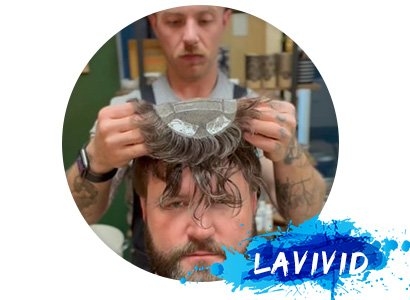
Today, we’re diving into an important topic: whether full skin hair systems can withstand the summer heat. This discussion stems from my recent experience during a particularly hot spell in the UK. While the insights are valuable for anyone experiencing similar weather conditions, they are especially relevant for those in consistently hot and humid climates.

My Experience with FullSkin Hair Systems in Heat
Last summer, I wore the same full skin hair system with minimal issues. The typical UK summer temperatures range from 15 to 25°C (60 to 70°F), and I only needed to rebond once every 1-2 weeks. However, this summer has been drastically different. With temperatures soaring to 32°C (90°F) daily, I’ve faced several challenges.
Increased Sweating and Discomfort
I’ve noticed increased sweating, more frequent lifts, and significantly more itchiness. I’ve had to rebond every five days, which is much more often than usual. This has given me a new perspective on the suitability of thicker full skin hair systems for hot and humid climates.
The temps were more moderate last summer, and my entire skin system let me easily handle. But this summer the intense heat has made life practically intolerable. The thicker complete skin retains heat, which causes more sweat to develop beneath and accelerates the breakdown of the adhesive, thereby lifting more often from the hair system.
Lace vs Ultra-Thin Skin Systems
Based on my experience and comments from viewers in hotter locations, it is abundantly evident that lace bases(Swiss or French) with ultra-thin skins (like the Mirage or Eros) are better suited for such temperatures. These fabrics let perspiration flow through and help to reduce heat build-up and hence lessen discomfort.

Particularly lace bases are recognized for their airliness. The little gaps in the lace let air flow, which cools the scalp. In warmer weather, this is especially important as it keeps the scalp from getting too itching and sweaty. Conversely, ultra-thin skins strike a mix between comfort and longevity. Their thinness lets some air flow while yet giving a strong adhesive bond.
Advice for Using Complete Skin Hair Systems in Warm Climates
Here are some pointers to help you to make the experience more controllable even if you would want to utilize a thicker poly system despite the heat:
Use Glue Over Tape: Tape can become itchy and messy in humid conditions. Glue tends to be more manageable and less irritating.
Why Glue? Glue provides a more secure bond and is less likely to be affected by sweat. Tape can break down quickly in humid conditions, leading to more frequent lifts. Glue, when applied correctly, can last longer and provide a more comfortable experience.
Prepare for Frequent Maintenance: Be ready to rebond every 5-7 days. While this might seem frequent, it’s essential for maintaining comfort and adhesion in hot weather.
Why More Maintenance? The increased sweat and heat can cause the adhesive to break down faster, necessitating more frequent maintenance. Regular rebonding ensures that the hair system stays secure and comfortable.
Avoid Sweating After Rebonding: For the first 12-18 hours after a rebond, try to stay cool and avoid sweating. This helps the glue bond properly. Stay in a well-ventilated room, use a fan, or turn on the air conditioning.
Why This Matters? The initial bonding period is crucial for the adhesive to set properly. Sweating during this time can weaken the bond and reduce the longevity of the attachment.

Personal Insights and Recommendations
In my recent experience, I found that the full skin system was much harder to manage in the heat compared to last year. This has led me to appreciate why many people in hot climates prefer lace or ultra-thin skin systems. These systems are not only more breathable but also less prone to causing irritation and discomfort.
Understanding the Chemistry
The chemistry of the adhesives also plays a significant role. Some adhesives are specifically formulated to withstand higher temperatures and humidity levels. It’s worth experimenting with different products to find the one that works best for your skin and climate.
Addressing Common Concerns
Many of you have reached out with concerns about managing hair systems in the heat. Here are a few common questions and my responses based on personal experience and feedback from the community:
Q: How can I reduce itching and irritation?
A: Use a breathable base like lace or ultra-thin skin. Ensure your scalp is clean before application and consider using a scalp protector. Keeping your scalp cool and dry is crucial.
Q: How often should I rebond my hair system in hot weather?
A: It depends on the adhesive and your individual skin chemistry, but generally, expect to rebond every 5-7 days. This may vary based on your activity level and how much you sweat.
Q: Are there specific products that work better in hot and humid conditions?
A: Yes, some adhesives are designed for high humidity. Walker Tape and Ghost Bond have products specifically formulated for hot weather. Experiment with different options to find what works best for you.
Conclusion
In conclusion, ultra-thin skins can handle summer heat effectively, but thicker full skin systems require more care. If you live in a humid area, I highly recommend considering lace or ultra-thin skin bases. These materials offer better breathability and comfort, reducing the need for frequent maintenance and minimizing irritation.
If you choose to stick with a thicker poly system, be prepared for more frequent maintenance and consider using glue instead of tape. Avoid sweating immediately after rebonding to ensure a strong bond.
I’d love to hear from those of you living in hot climates. How do you manage your hair systems? What bases work best for you? Share your experiences in the comments below.
Lastly, I’m receiving a lot of interest in one-on-one sessions. Would you prefer an online booking system to streamline scheduling? Let me know in the comments, and I’ll work on setting it up.


Comments (0)